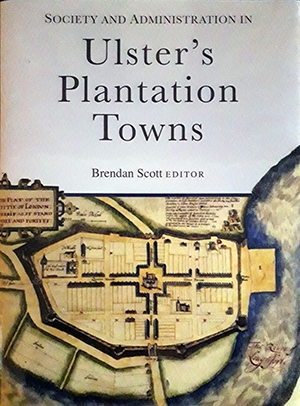SOCIETY AND ADMINISTRATION IN ULSTER’S PLANTATION TOWNS
Published in Book Reviews, Book Reviews, Issue 3 (May/June 2020), Reviews, Volume 28BRENDAN SCOTT (ed.)
Four Courts Press
€50
ISBN 9781846827358
Reviewed by David Heffernan
David Heffernan is a historian of Tudor and early Stuart Ireland.
 The role of the towns in the Ulster Plantation initiated around 1609 by the government of James I has always been central to the broader historiography of the plantation during the seventeenth century. This field of study was largely pioneered by Robert Hunter in the 1970s and it is fitting that this latest contribution to the topic should be dedicated to that doyen of Ulster plantation studies. Society and administration in Ulster’s plantation towns, edited by Brendan Scott, is a fine contribution to the field, offering eleven nuanced and interesting essays on how Ulster’s new urban network developed across the course of the seventeenth century.
The role of the towns in the Ulster Plantation initiated around 1609 by the government of James I has always been central to the broader historiography of the plantation during the seventeenth century. This field of study was largely pioneered by Robert Hunter in the 1970s and it is fitting that this latest contribution to the topic should be dedicated to that doyen of Ulster plantation studies. Society and administration in Ulster’s plantation towns, edited by Brendan Scott, is a fine contribution to the field, offering eleven nuanced and interesting essays on how Ulster’s new urban network developed across the course of the seventeenth century.
There are a great many topics relating to the towns here, with everything from religious life, economic activity and town governance to ethnic relations and the physical development of these urban spaces being addressed. Bríd McGrath offers a typically forensic and insightful assessment of the development of the town of Coleraine during the early Stuart period. The voluminous records of the London livery companies, extant today in their individual company halls in London, the Guildhall Library and other archives further afield, remain the major under-utilised body of sources for the early history of the plantation. Here Annaleigh Margey utilises these records to highlight how the companies developed smaller urban settlements in the county lands of Londonderry in the 1610s and 1620s, including a welcome case-study of the Grocers Company’s settlement at Muff near Derry. William Roulston focuses on nearby Strabane in north-west Tyrone. The town evolved throughout the course of the seventeenth century under the proprietorship of successive generations of the Hamilton family. This and numerous other essays in the volume serve to highlight the variegated manner in which the towns developed and who the principal agents were in fostering individual urban settlements.
The second half of the volume gives way to the consideration of more thematic issues of social arrangement, religion and economic activity. Raymond Gillespie presents a study of how a network of fairs and markets grew up around the urban centres of plantation Ulster in the seventeenth century. Gillespie’s appendix presenting the details of the market towns, their creation dates and the extent of the towns in question (where available) will be a valuable reference tool for anyone working on Ulster’s urban history in the early modern period. In his chapter on the Irish and urban Ulster, Gerard Farrell saliently notes the influence of pre-plantation Ulster on the development of the plantation town network. Many of the sites that were selected for the creation of towns during the planning stage of the plantation between 1608 and 1610 had long been centres of commerce, trade and limited settlement for the Irish of Ulster, even if not towns in their own right. Thus the plantation town network was essentially superimposed over a web of locations that had been used extensively for trade and settlement in pre-plantation Irish Ulster. Other essays delve in detail into case-studies of towns such as Belturbet, the varying fortunes of Catholicism and Protestantism in plantation Ulster and the urban poor in Stuart Ulster. A series of nineteen high-quality colour plates provides the reader with a satisfying visual complement to these papers.
What might one quibble about in this volume? There is something of a geographic imbalance. Urban development in plantation Fermanagh, for instance, gets only limited coverage, despite the emergence of a number of significant towns there, while the many mid-sized towns that emerged along the coast and in the north-east of plantation Donegal are similarly marginalised. Admittedly this is not something that can really be controlled in an edited volume. An imbalance which might have been addressed concerns the coverage of various parts of the seventeenth century. Although the title of the book does not explicitly indicate this, nor does it contain a date range, the collection is, broadly speaking, dealing with the urban network that developed across the six planted counties in the course of the seventeenth century. In this respect it might perhaps have been desirable to have had one or two further essays addressing the second half of the seventeenth century more directly, particularly the tumultuous period of the 1640s, 1650s and 1660s. For instance, a paper specifically on how the towns of Ulster fared during the 1640s and then recovered in the 1650s would have rounded off the papers provided on the 1609 to 1641 period very well.
Nevertheless, when assessed on what is actually in it the volume is a significant collection. The broad pattern of the plantation’s impact on Ulster’s urban landscape has been known for quite some time, but what the essays in this volume wholly achieve is to add significant nuance and texture to our understanding of Ulster’s plantation towns during the seventeenth century. As such, ably edited by Brendan Scott and finely produced by Four Courts Press, this volume is a significant continuation of the work pioneered by Robert Hunter many years ago.
















